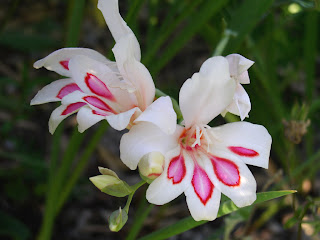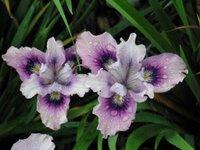
One of the effects of the increased planting of native plants has been the resurgence of interest in grasses and grass-like plants. Most gardens now have areas devoted to very naturalistic plantings, featuring different species of grasses, often clumped into groups of one or two species. When this is done well it can be stunning. When it is not carried off so well, the result can be very disappointing.
One of the problems is that we try to grow alpine plants in our lowland gardens, and some plants will just not cope with it. Many of the native grasses and sedges grow into ugly messes, and require frequent division to keep tidy, especially in rich soil conditions.
I am a great fan of the effect that can be afforded by use of grass-like plants. My front garden features a large bed of Pacific Coast irises, grown for their flowers of course, but the plants have strappy foliage, evergreen, and more than one gardening friend, visiting out of flowering season, has commented on the bed of grasses!
Modern gardeners have the option of using a wide range of native and near-native (for which read Australian) plants that will do the trick very well. Obviously our flaxes, especially the dwarf forms, are ideally suited to these situations, and other plants like dwarf cabbage trees and Libertias, with their wide colour range, are also well-suited to the job.
Among the Australians surely the most interesting and useful plants are the, Lomandras. These are members of the matt rush family, and in the main have quite strappy leaves. The wild species look quite a lot like New Zealand flax, but nurserymen have been selecting special forms for the garden, and there are some very interesting plants among them.
Lomandra longifolia looks like a slightly refined flax, but the new cultivar ‘Tanika’ makes an absolutely stunning grass-like plant for the garden, or for containers. It is bright green, with a hint of yellow, and seems perfectly hardy in the Wairarapa winter. Friends who grow it commercially tell me that it is a quick-growing species to about 800 mm high, with a graceful, drooping growth habit. It retains its form very well, and can cope with frost and even damp conditions. It is equally at home in dry positions, where it will not grow quite as large. It has intriguing flower spikes in the spring, with light yellow flowers held along long stems.
“Nyalla” is sometimes described as the blue-leaved equivalent of “Tanika”, and it does have a distinct blue tone. It is not as blue as a fescue or the stunning blue oat grass, Helictotrichon sempervirens, but it is a clear steely blue shade that will offer a great contrast to the greener “Tanika.” It is not as finely foliaged, and will grow a little larger eventually, but it looks stunning when planted alongside its green counterpart.
There are some lovely smaller growing forms, with bright green foliage. Perhaps the best two are “Little Con” and “Little Pal.” The former is the smaller form, growing to about 30 cm high, and with similar girth. It is great for dry situations, and does not brown off. It has small spikes of cream flowers in spring. This variety could be used as a bright substitute for mondo grass, Ophiopogon.
“Little Pal” will grow about twice as high as the forgoing, but has similar bright green leaves which bend and flow in the wind. This has yellow and burgundy flower spikes in the spring, and is a fabulous grass-like for massed plantings.
All the above Lomadras grow exceptionally well in pots, and do not need a lot of care once they are established. They grow well in coastal areas too.
One of my favourite native plants is the blue berried Dianella nigra. Last summer I found a big clump of these with light blue berries in the Tararuas – a nice change from the deeper purple forms usually seen.
Dianellas are found on the other side of the Tasman too and they have been developed as grass and flax substitutes, and again offer a great variety of plants for the New Zealand gardener looking for a different grass.
“Little Rev” is a delightful small growing foliage plant. This looks like a dwarf New Zealand flax, as it has slightly broader leaves than the Lomandra varieties, but it has a blue tinge that you will not find among flaxes. It grows to about 40 cm high and wide, and can cope with full sun or light shade. The blue tinge is most pronounced in full sun.
In case you are wondering how it was named, it has no religious connotations - it is a dwarf form of the species D. revoluta
“Little Jess” grows to a similar size, but has a slightly different habit. It grows on short canes, somewhat like a bamboo, or one of the crested irises. It makes a tight clump that is weather tolerant. Spring flowers of bluish-purple are succeeded by summer berries.
“Tas Red” is different again, looking a little like one of the pink foliaged flaxes. It is, in fact, a form of D. tasmanica, and features leaves having a red base and margins and lighter tones up the leaf. It colours up best in cooler districts, so should do well with us. Again, it has blue flowers in spring, followed by purple berries.
All these grass-like plants look stunning when associated with plants of similar types, or with plants with large leaves, for which they act as a perfect foil.
I am sure that these will become staples of the New Zealand garden, just as they are rapidly becoming popular in their homeland.















 Water lily 'James Brydon' and fish
Water lily 'James Brydon' and fish 2004-41
2004-41 2004-053
2004-053 2005-004
2005-004 2005-053
2005-053 

 Bridal Veils Falls
Bridal Veils Falls











